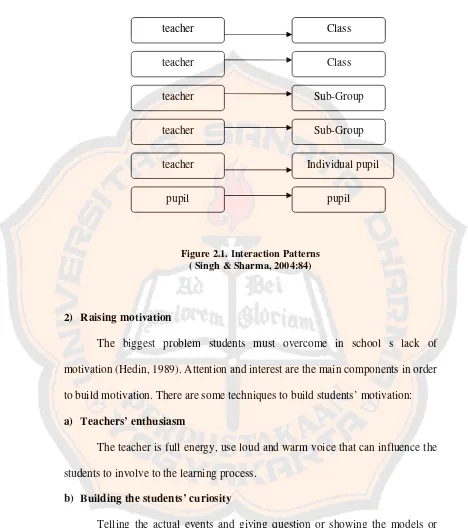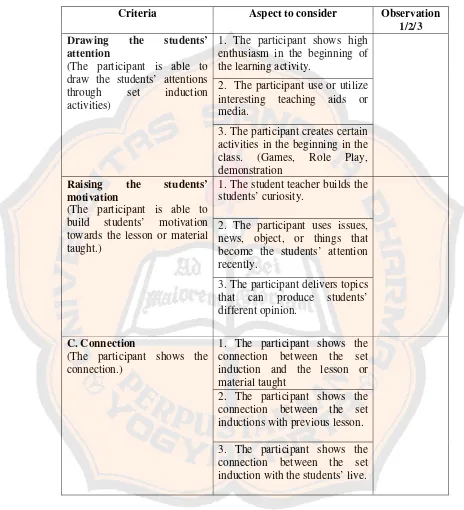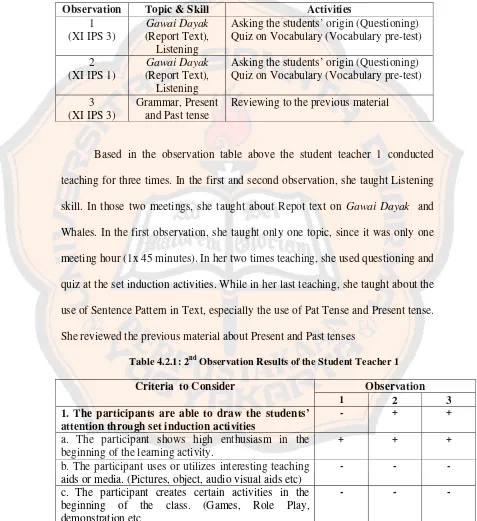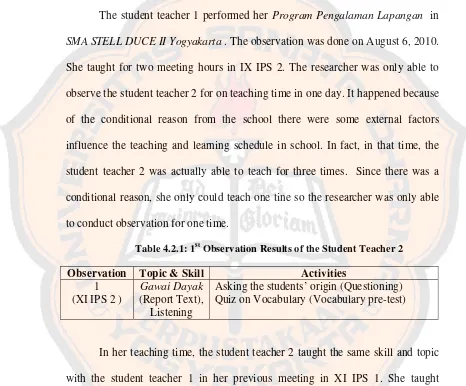Informasi Dokumen
- Penulis:
- Christina Endang Wijayanti
- Sekolah: Sanata Dharma University
- Mata Pelajaran: English Language Education
- Topik: The Student Teachers’ Teaching Skills in Set Induction as seen in Their Program Pengalaman Lapangan
- Tipe: Thesis
- Tahun: 2011
- Kota: Yogyakarta
Ringkasan Dokumen
I. Introduction
This chapter sets the stage for the research by establishing the context of student teachers' teaching skills, specifically focusing on set induction within the Indonesian 'Program Pengalaman Lapangan' (PPL). It highlights the significance of effective lesson openings in fostering meaningful learning experiences and emphasizes the role of set induction as a crucial teaching skill. The chapter further introduces the research problem, its limitations, objectives, benefits, and key definitions of terms like 'student teacher,' 'set induction,' and 'PPL,' providing a foundational understanding of the study's scope and purpose.
1.1 Research Background
This section establishes the importance of effective lesson openings and introduces the concept of 'set induction' as a critical teaching skill. It emphasizes the need for student teachers to master this skill to create engaging and effective learning environments. The background also introduces the PPL program in Indonesia, highlighting its role in providing practical teaching experience and training student teachers in fundamental teaching skills. The section connects the importance of set induction to successful teaching, emphasizing its place within a broader framework of effective lesson planning and delivery.
1.2 Problem Formulation
This section clearly articulates the central research questions that guide the study. The three research questions focus on how student teachers conduct set induction during their PPL, the problems they encounter, and the strategies they employ to overcome these challenges. These questions directly address the core issue of the study and provide a roadmap for the subsequent data collection and analysis.
1.3 Problem Limitation
This section outlines the specific boundaries and parameters of the study. The research focuses solely on the PPL performance of English Language Education Study Program (ELESP) students at Sanata Dharma University, specifically those undertaking their teaching practice at SMA STELLA DUCE II Yogyakarta during a particular academic semester. This clearly defines the population and scope of the research, preventing unwarranted generalizations.
1.4 Research Objectives
This section clearly states the intended outcomes of the research. The objectives describe what the research aims to achieve. These objectives are directly tied to the research questions and provide a clear focus for the research process. They outline the expected outcomes of the data analysis and provide a framework for interpreting the findings.
1.5 Research Benefits
This section identifies the potential contributions of the research to various stakeholders. The benefits outlined include providing valuable insights for lecturers, student teachers, and future researchers in the field of teacher education. It emphasizes how the findings can improve teacher training programs, enhance student teachers' skills, and contribute to the body of knowledge on effective teaching practices.
1.6 Definitions of Terms
This section clarifies any ambiguity related to key terms used in the study, ensuring consistent and precise language throughout. The definitions of 'student teacher,' 'set induction,' and 'Program Pengalaman Lapangan (PPL)' provide a clear understanding of the central concepts and their application within the research context, preventing potential misinterpretations.
II. Review of Related Literature
This chapter delves into the theoretical underpinnings of the study, providing a comprehensive overview of existing research and theories relevant to set induction and its role in effective teaching. It examines different definitions of set induction, its purposes, and the various methods or techniques that can be employed. The chapter also explores the criteria for effective set induction and discusses the theoretical framework that guides the research.
2.1 Theoretical Description
This section offers a detailed examination of the nature and definitions of set induction, drawing upon various theoretical perspectives and scholarly sources. It explores the different interpretations and applications of set induction, including its purposes and the criteria for its effectiveness. The section also considers the various methods and techniques that can be used in set induction, providing a broad understanding of the concept's practical application within teaching and learning contexts.
2.2 Theoretical Framework
This section synthesizes the relevant theories and concepts discussed in the previous section, creating a coherent theoretical framework to guide the research. It integrates different theoretical perspectives to provide a structured understanding of the research problem. The framework clarifies the relationship between the key concepts, providing a clear lens through which the data will be analyzed and interpreted.
III. Methodology
This chapter outlines the research design, methods, and procedures employed in the study. It details the research approach (descriptive-qualitative), participant selection, data collection instruments (classroom observation, field notes, interviews), data gathering techniques, and data analysis methods used to address the research questions. The procedures involved in data collection and analysis are explained step-by-step.
3.1 Research Methods
This section details the qualitative research approach used, justifying the choice based on the research questions and objectives. The descriptive-qualitative nature of the study is explicitly stated, and the rationale for selecting this approach is explained, emphasizing its suitability for exploring the complexities of student teachers’ teaching practices in a naturalistic setting.
3.2 Research Participants
This section describes the selection of participants for the study, outlining the specific criteria used. The three student teachers chosen from a specific school and program are identified, providing a clear understanding of the research sample. The rationale for selecting this specific group is provided, along with any limitations associated with the sample size.
3.3 Research Instruments
This section describes the tools used for data collection: classroom observation, field notes, and interviews. Each instrument is described in detail, including its purpose and how it will be used to gather relevant data. The validity and reliability of the instruments are also addressed, explaining the measures taken to ensure the accuracy and consistency of data collection.
3.4 Data Gathering Techniques
This section explains the procedures used to collect data using the instruments described previously. It provides a clear step-by-step account of how the data was collected, highlighting the process of classroom observation, note-taking, and conducting interviews with the student teachers. Ethical considerations, such as informed consent, are also addressed.
3.5 Data Analysis Techniques
This section details the approach used to analyze the collected data. The methods used to analyze the qualitative data obtained through observations and interviews are described, highlighting the steps taken to identify themes, patterns, and insights related to the research questions. The analytical framework used is explained, clarifying how the data will be interpreted and used to answer the research questions.
3.6 Research Procedures
This section provides a comprehensive overview of the steps taken throughout the research process, from the initial planning stages to the final data analysis and interpretation. The chronological sequence of activities is clearly outlined, illustrating the different phases of the research and their interrelationships. This provides a clear and transparent account of the research methodology.
IV. Research Findings and Discussion
This chapter presents the findings of the study, organized according to the research questions. It describes the student teachers' set induction practices, identifies the challenges they encountered, and examines their strategies for overcoming these challenges. The findings are then discussed in relation to existing literature and theories, drawing insightful conclusions and implications.
4.1 Research Findings
This section presents the results of the data analysis, organized according to the three research questions. It provides a detailed description of how the student teachers conducted set induction, the problems they faced, and the solutions they implemented. The findings are presented clearly and concisely, supported by relevant data extracts and examples from the observations and interviews.
4.2 Discussion
This section interprets the research findings in relation to the existing literature and theoretical frameworks discussed in Chapter II. It examines the implications of the findings, exploring their significance within the context of teacher education and effective teaching practices. The discussion also addresses any limitations of the study and suggests avenues for future research.
V. Conclusions and Suggestions
This chapter summarizes the main findings of the research, restating the answers to the research questions. It offers concluding remarks and suggests practical implications for teacher education programs and future research directions. This section summarizes the key insights gained from the study and offers recommendations for enhancing the teaching skills of student teachers.
5.1 Conclusions
This section provides a concise summary of the main findings, emphasizing the key insights derived from the research. The conclusions are directly linked to the research questions and findings, providing a clear and concise summary of the study's outcomes. It reiterates the primary answers to the research questions and emphasizes the significance of the study's findings.
5.2 Suggestions
This section offers practical recommendations based on the research findings. It suggests ways to improve teacher education programs, focusing on strategies to enhance student teachers' skills in set induction. It also proposes areas for future research, suggesting potential extensions or refinements of the present study. This section bridges the gap between the study's findings and their potential impact on teacher education.
Referensi Dokumen
- The Student Teachers’ Teaching Skills in Set Induction as seen in Their Program Pengalaman Lapangan ( Wijayanti, Christina Endang )







